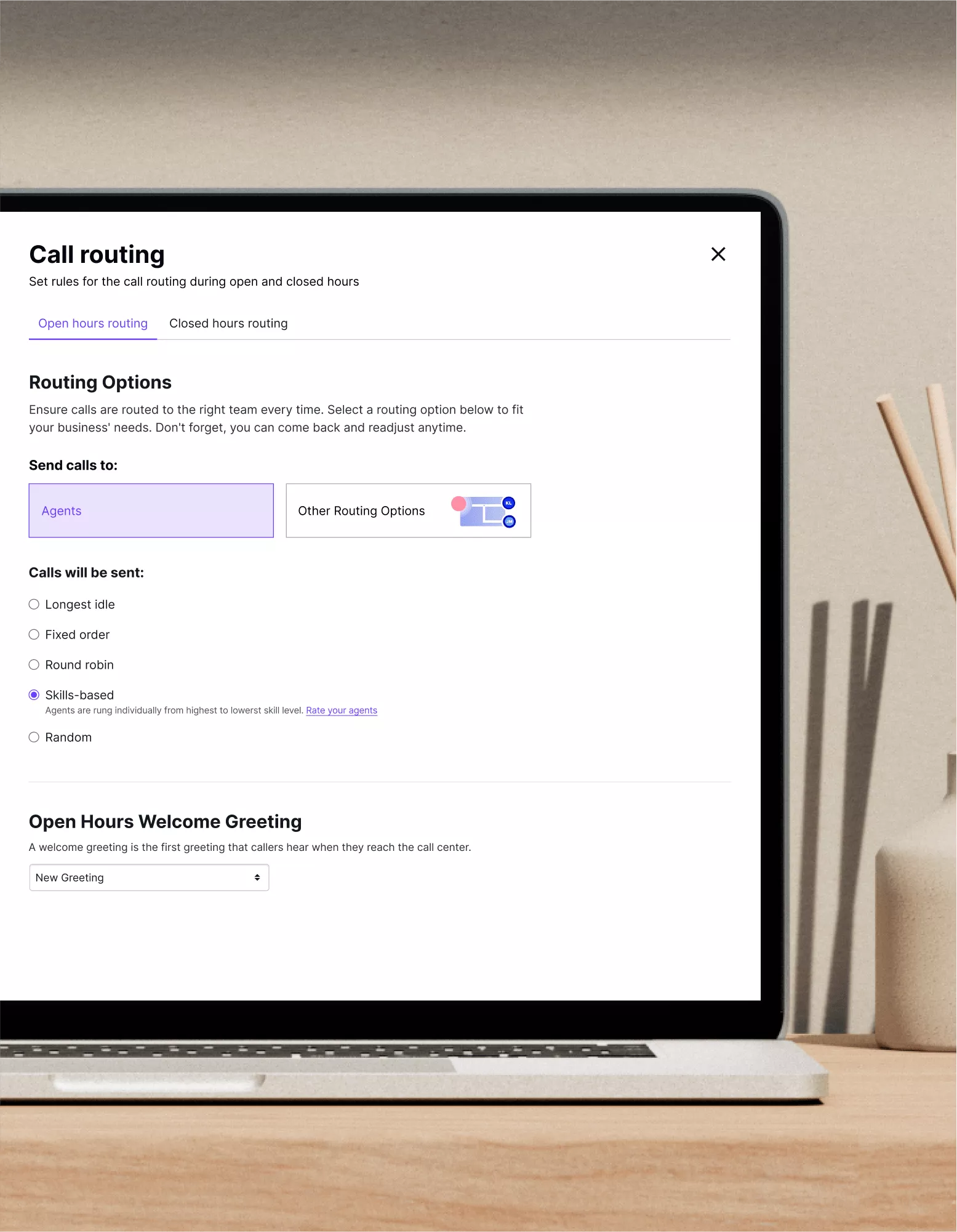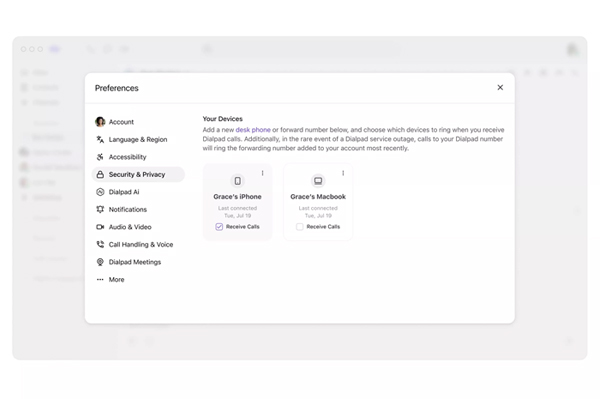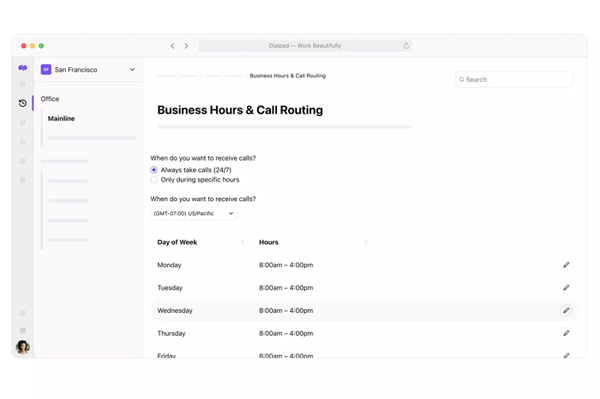FAQs about virtual receptionists
-
Does virtual receptionist cost extra?
Nope. Auditcall’s virtual receptionist (auto attendant) is a standard business feature and included in every business phone plan at no extra cost. That means you’re also getting Auditcall’s other features, whereas some phone answering services, such as Nexa, charge additional fees for things like CRM admin support, calendar appointment-setting, and text messaging.
Maybe you’ve considered outsourcing to a live virtual receptionist service such as Smith.ai, Ruby Receptionists, or PatLive, but you’re still effectively paying for human employees. An automated system will cost you less in the long run, especially if it’s part of a cloud-based platform that already represents great value for money.
If you want to, you can still choose to employ a live receptionist during the workday, but use a virtual receptionist outside of business hours to help callers find information and answers to simple queries. You’re in complete control of the hours you want your auto-attendant to be active.
Auditcall’s virtual receptionist is a very affordable way to make your business more efficient and give a professional appearance to all callers. -
What happens if the department a caller is trying to reach is busy?
What happens next depends on the rules you’ve put in place. Callers may hear a default or custom message, they may be invited to leave a voicemail, or they can return to the automated menu to make an alternative choice.
With a self-service menu, you let the incoming caller choose how they want their call handled (based on the rules you choose). They can look someone up by name or by extension, they can search for a department, or they can just leave a voicemail.
You could set a rule that if a certain department is busy, there’s a “next-best” option where calls will be automatically diverted. Auditcall also enables you to have urgent calls routed to your mobile device at any time, wherever you’re based.
You can also choose which music to play if a caller has to be placed on hold until the employee or department is ready. Auditcall has a list of tracks to pick from, or you can customize this by uploading your own audio file.
-
Can I customize my greeting message?
Yes. Auditcall allows you to customize virtual receptionist messages for your main company number and departments, providing a consistent and professional first point of contact.
Your auto-attendant can deliver whatever message you like, and you don’t have to stick with the same greeting forever—it’s easy to change it for weekends or holiday season, to update information, or to keep things fresh.
You can program the system to give out different greetings for specific times or dates, or to promote occasional special offers. You could even invite customers to leave feedback on their virtual receptionist experience, which you can use to make extra improvements.
For your bilingual or multilingual customers, Auditcall provides a wide range of IVR language options including English, French, German, Chinese, Portuguese, Japanese, Spanish, and Italian. Choose according to region or customer demographics.
-
What happens if none of the operators are available to answer a call?
Depending on the call routing rules you establish, calls will be sent directly to voicemail (operators receive notifications when voicemails are left), or to a greeting, or to another department or team member. Calls can even be routed to numbers outside Auditcall.
You can choose your preferred fallback options for unanswered calls, such as directing callers to your other communication channels like messaging or web chat. You can even specify how long you want calls to ring out before the system assumes nobody is available and directs the call elsewhere.
Another option is to return the caller to the automated menu. If the caller does not select an option after the menu repeats twice, the default setting is that calls will end automatically at this point. However, you can set your own default option (you might play a message, invite them to leave a voicemail, or forward the call to a different number).
The ability to leave a message or use the self-service options to solve an issue themselves is great for customers who need to contact you outside traditional office hours. If you’re running a global organization with customers or colleagues in different time zones, they won’t have to wait until your region comes back online before their query can be answered.
-
How do I establish a logical call sequence for my virtual receptionist?
If your call sequence isn’t logical, callers may get caught in an endless loop of options. Think carefully about the best route for different types of call before you create your menu and call flow.
You basically want to create a decision tree, with the ideal option at the top (the person or department the caller actually wants to speak to) and then the next-best options in descending order of usefulness. Make sure the routing is effective for both customers and staff.
The routing process is divided into three phases: Qualifying, call queuing, and call distribution. Live calls are sent to the IVR system, which identifies the caller’s needs via a series of automated questions (Auditcall lets you review this to see which options are most popular).
The call is then forwarded to the automatic call distributor (ACD) and put in a call queue. Finally, it is routed to the right person based on the rules you’ve made.
You might want to set call routing rules to apply at different times of the day or week, or customize your prioritization to favor emergency call queues. Whatever routes you choose, they should be as efficient as possible, so that employees never get overwhelmed by call volume.
-
How do I make recordings sound inviting and approachable?
Depending on your business, the messages can either be formal or informal. Regardless of the formality though, you can make sure the recorded greeting sounds welcoming and friendly by choosing a voice actor or employee who has a positive or pleasant tone of voice and clear enunciation.
If you're the one recording the greeting, spend some time on coming up with the message scripts, and practise them a few times before hitting record.
It’s important to keep messages concise and relevant, and to make the caller feel valued by reassuring them that they’ll be directed to the right place or that someone will call back as soon as possible. -
What should employees know about the virtual receptionist?
All customer-facing employees should be aware of how the virtual receptionist works, how to change the settings (if they are required to do this as part of their job), and what the messaging says (in case customers ask about it). They should also be aware of the call flow so that they know how many calls to expect.
-
How many options is ideal for a virtual receptionist?
This really depends on the size of your business. Larger companies with multiple departments and employees should carefully consider how many options the caller will need, and what is the clearest way to present them.
You don’t want callers to be overwhelmed—the last thing they want is to have to loop the message again because they forgot whether they wanted option #6 or #27! Ensure that the recording is crystal clear (that’s a given with Auditcall’s HD audio settings) and makes the menu super-easy for callers to understand. -
How does a virtual receptionist improve productivity?
Virtual receptionists help you to handle large call volumes with maximum efficiency. Calls are always directed to the right place, so there are no long wait times for customers and no time wasted in passing callers around. Even if two (or more) people dial the business number simultaneously, both calls will be greeted by the virtual assistant and routed to their respective destinations.
The system also makes your business more productive by reducing the number of calls that employees have to answer. With the auto-attendant filtering inbound calls and resolving simple queries through the IVR menu, workers will have more time to spend on other tasks such as making outbound calls. Virtual receptionists can even block most spam calls, freeing up staff to handle genuine inquiries.
The increased productivity from these streamlined workflows will also bring cost savings. Plus, you should get more sales conversions as calls are always answered and customers are kept happy. That’s why a virtual receptionist is a crucial tool for contact centers and call centers, and for small businesses that do their own call handling.

 +1 (270) 716-7625
+1 (270) 716-7625







